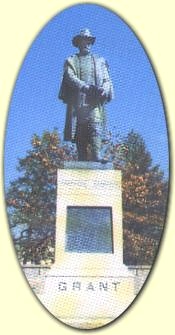Leavenworth County, KS
 The land where Leavenworth and Fort Leavenworth are located today was originally inhabited by the Kansa, Osage and Delaware Indians and today many of our streets are named after these and other local Indian tribes.
The land where Leavenworth and Fort Leavenworth are located today was originally inhabited by the Kansa, Osage and Delaware Indians and today many of our streets are named after these and other local Indian tribes. Somewhere in the vicinity of present day Salt Creek Valley northeast of Leavenworth, the French operated a fur trading post for possibly a score of years in the mid-1700's. This was the earliest white settlement of the region.
In 1827, Colonel Henry Leavenworth founded Fort Leavenworth on the bluffs of the Missouri River. For the next several decades Fort Leavenworth played an important role in keeping the peace among the various Indian tribes and the increasing number of settlers heading west. By the 1840's, travel to Oregon and California had begun and thousands of wagons passed through Fort Leavenworth on the way to the Santa Fe and Oregon Trail.
In 1854, the City of Leavenworth was founded as the very first city of Kansas.
In 1858, the Sisters of Charity of Leavenworth settled here. In 1864, the Sisters opened St. John's Hospital and in 1923 founded St. Mary College.
In 1863, the legislature passed an act to erect the Kansas St. Penitentiary on a site which is now located within the city of Lansing. The contract to build the prison was let in 1863 and work started in 1864. However, because of money difficulties connected with the Civil War, work stopped in 1864 and did not resume again until 1866. The building was first occupied in 1868.
In 1878, Lansing was platted into town lots.
In 1881, the school that was later to become the U.S. Army Command and General Staff College was founded on Fort Leavenworth by General William T. Sherman. Some of the many famous students and instructors at the college are George C. Marshall, Dwight D. Eisenhower, Douglas MacArthur, Colin Polwell and George Patton.
In 1885, the Wadsworth of Old Soldiers Home was built, and later became the Veterans Administration Center. In 1893, the Immanuel Chapel, made famous in Ripley's "Believe It or Not", was built on the V.A. grounds.
In 1906, the first cellhouse of the Leavenworth Federal Penitentiary was opened. Among the infamous criminals incarcerated here were Al Capone, Machine Gun Kelly and Robert Staud, the Birdman of Alcatraz.
There are a great deal of wonderful sites and experiences waiting for you and we hope that you will get the opportunity to enjoy some of our renowned Kansas hospitality.
Explore Leavenworth County
Oregon and Santa Fe Trails
In the 1830s, settlers heading for the Oregon and Santa Fe Trails crossed the Missouri River at this point. Teams of oxen pulled the loaded wagons through the "cut " in the hillside you can still see today.
Fort Leavenworth, KS Pioneer LifeLansing Correctional Facility
The Lansing Correctional Facility (LCF) is the oldest and largest facility in the Kansas Department of Corrections (KDOC) for detention and rehabilitation of male adult felony offenders. Legislatively approved in 1861, LCF is built on 2,711 acres. Accredited most recently in 1996
Lansing, KS PenitentiariesMain Parade Ground
The main parade ground was originally the center of post activities. Post reviews and parades were held here during negotiations with federal officials in the 1800s.
Fort Leavenworth, KS Military HistoryHeadquarters Area
Headquarters area buildings are named for Generals Sherman, Grant, and Sheridan. They were built from 1859 to 1904 and are on the site of the former soldiers burying ground.
Fort Leavenworth, KS Historic BuildingsThe Honey Valley School
As one of four buildings on the Tonganoxie Historical Society site, the Honey Valley schoolhouse – district #56 - was organized on March 25, 1869. It was located about a mile south of Tonganoxie on the Gordon Harmon Farm -near County Road 1 and U. S. Highway 24-40
Tonganoxie, KS Historic SchoolhousesBuffalo Soldier Monument
The Buffalo Soldier Monument, the brainchild of General Colin Powell, is a recent addition to Fort Leavenworth's historic landmarks. Dedicated in 1992, the monument honors the African-American soldiers who served in the 9th and 10th Cavalry Regiments.
Fort Leavenworth, KS MonumentsPerforming Arts Center
Placed on the National Register of Historic Places, this 1938
Leavenworth, KS TheatresSt. Ignatius Chapel
The St. Ignatius Chapel was built here in 1889 and replaced the original chapel which had been built near here in 1871. Historical Marker (1967) - "
Fort Leavenworth, KS Historic ChurchesFrench Cannons
These beautiful artifacts of bygone wars remain a mystery at Fort Leavenworth. They were cast in the 1700s in Paris; the name of the foundryman and place and date of manufacture are on each piece. How or why they came to Leavenworth is unknown.
Fort Leavenworth, KS Military HistoryUnited States Penitentiary -
Leavenworth is best known for the "Federal Pen" or "Big House", which is now a medium-security prison. Construction of this historic prison began in 1897, with the first cell house opening in 1906. The Federal Penitentiary has been the home of Kansas City Boss Tom Pendergast, George "Machine Gun"
Leavenworth, KS PenitentiariesTonganoxie Community Historical Society Museum
The Tonganoxie Community Historical Society (TCHS) owns and operates 10 acres, called the Site, with four buildings. They are The Honey Valley School house, Reno Methodist Church, Fairchild/
Tonganoxie, KS MuseumsCity Parks
Visitors can enjoy outdoor recreational activities at one of Lansing's four parks. LOST 80
Lansing, KS Recreation